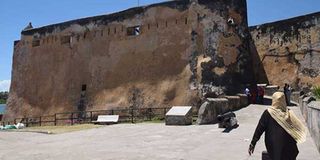Fort Jesus: One of the most popular Coast tourist sites

Fort Jesus, the imposing landmark located along the coastline, near Mombasa Old Town and which was built by the Portuguese towards the end of the 16th century. PHOTO | WACHIRA MWANGI | NATION MEDIA GROUP
What you need to know:
- The Portuguese kept it under their control for one century.
- Fort Jesus bears testimony to the first successful attempt by Western civilisation to rule the Indian Ocean trade routes.
- The fort served as barracks for the soldiers and was later converted to a prison when the British protectorate was proclaimed.
You cannot tell the story of Kenya’s coast without talking about Fort Jesus, the imposing landmark located along the coastline, near Old Town.
It was built by the Portuguese towards the end of the 16th century at the southern edge of the town of Mombasa, over a spur of coral rock.
The Portuguese kept it under their control for one century.
Fort Jesus bears testimony to the first successful attempt by Western civilisation to rule the Indian Ocean trade routes, which, until then, had remained under Eastern influence.
BUILT FOR SAFETY
It was built to ensure the safety of the Portuguese on the East Coast of Africa.
The fort served as barracks for the soldiers and was later converted to a prison when the British protectorate was proclaimed.
This national treasure is managed by the National Museums of Kenya.
The design of the fort, its proportions, its imposing walls and five bastions, all reflect the military architectural theory of the Renaissance.
You could say that this world heritage site is one of the most outstanding and well-preserved examples of 16th-century Portuguese military fortification.
The architecture of the fort resembles a rough outline of a person lying on his back, his head facing the sea.
OMAN HOUSE
The Oman House, the living quarters of the sultan who governed the East African coast, still stands in the fort.
Other historical structures that are still intact include an open water cistern, which the Portuguese used to harvest rainwater, as well as a 76-foot deep well sunk by the Arabs.
The water here is said to be too salty for domestic use.
Other than being a popular destination for local and foreign tourists, Fort Jesus is an important site for various research programmes.
It hosts a conservation lab as well as an office.




